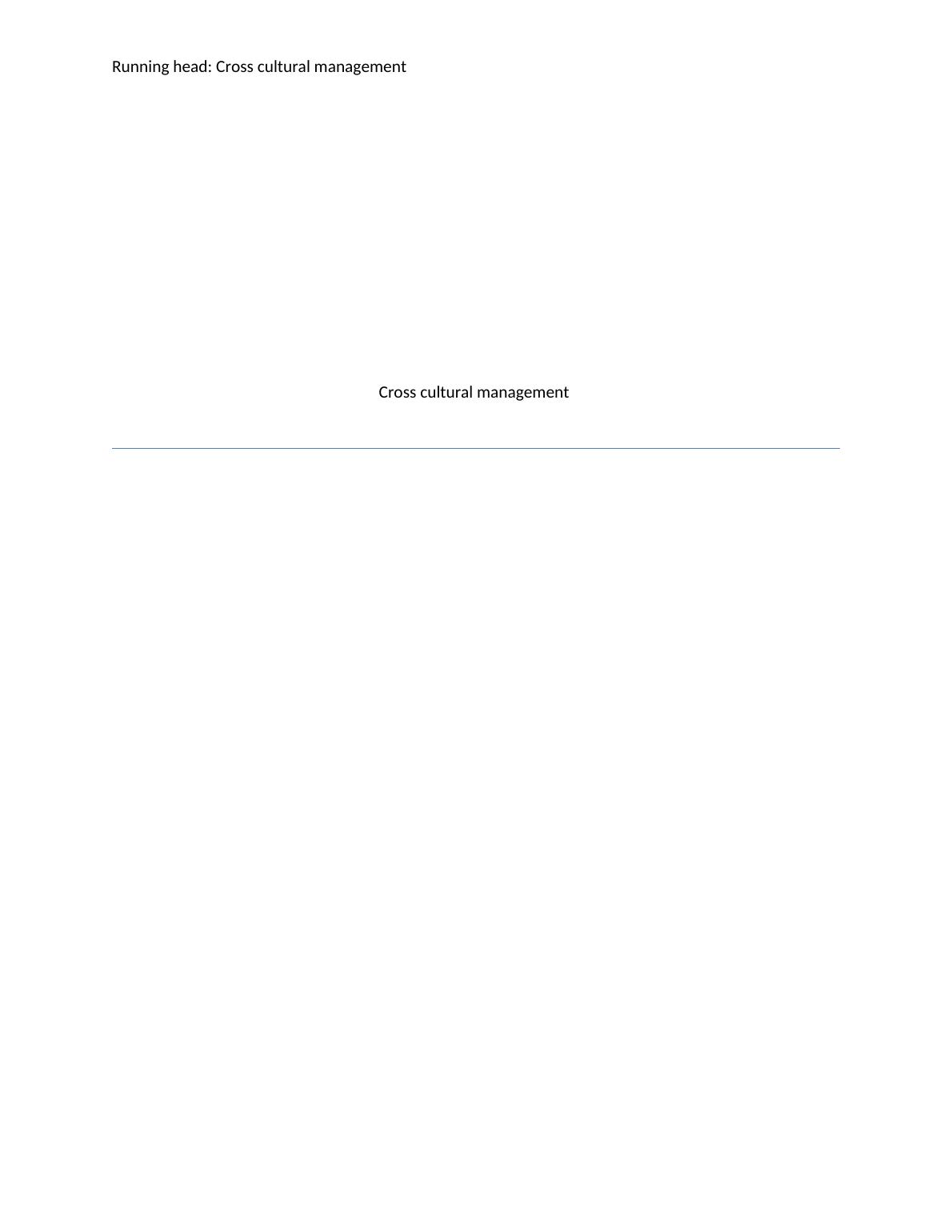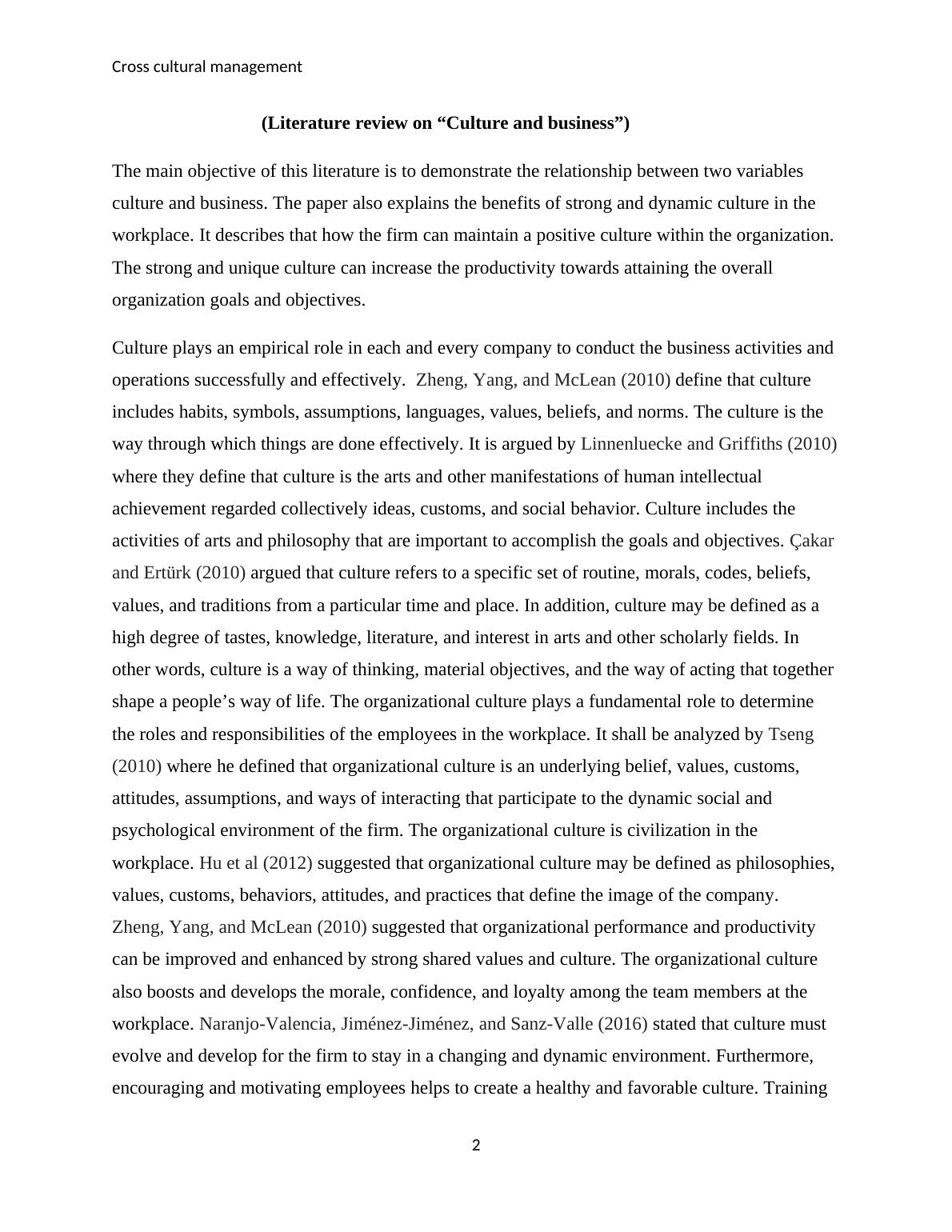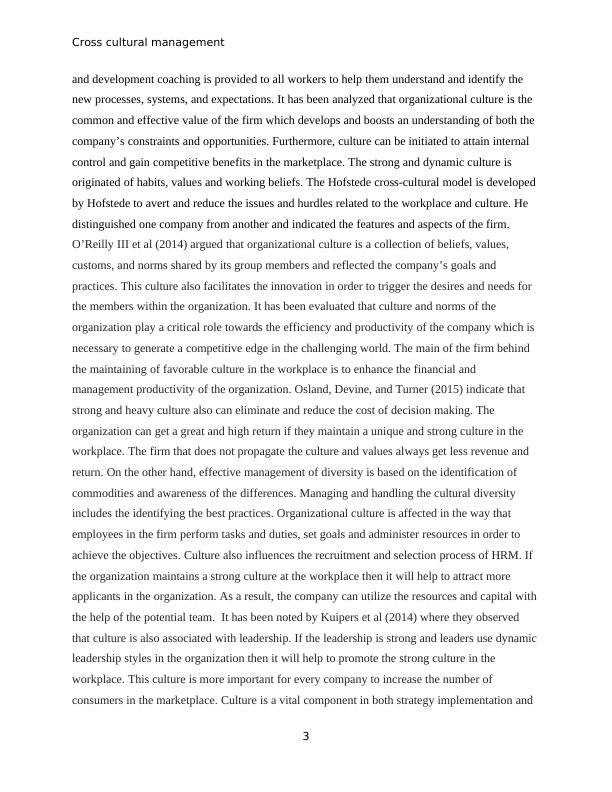Cross Cultural Management: Doc
Added on 2021-06-17
8 Pages2964 Words22 Views
Running head: Cross cultural management
Cross cultural management
Cross cultural management

Cross cultural management
(Literature review on “Culture and business”)
The main objective of this literature is to demonstrate the relationship between two variables
culture and business. The paper also explains the benefits of strong and dynamic culture in the
workplace. It describes that how the firm can maintain a positive culture within the organization.
The strong and unique culture can increase the productivity towards attaining the overall
organization goals and objectives.
Culture plays an empirical role in each and every company to conduct the business activities and
operations successfully and effectively. Zheng, Yang, and McLean (2010) define that culture
includes habits, symbols, assumptions, languages, values, beliefs, and norms. The culture is the
way through which things are done effectively. It is argued by Linnenluecke and Griffiths (2010)
where they define that culture is the arts and other manifestations of human intellectual
achievement regarded collectively ideas, customs, and social behavior. Culture includes the
activities of arts and philosophy that are important to accomplish the goals and objectives. Çakar
and Ertürk (2010) argued that culture refers to a specific set of routine, morals, codes, beliefs,
values, and traditions from a particular time and place. In addition, culture may be defined as a
high degree of tastes, knowledge, literature, and interest in arts and other scholarly fields. In
other words, culture is a way of thinking, material objectives, and the way of acting that together
shape a people’s way of life. The organizational culture plays a fundamental role to determine
the roles and responsibilities of the employees in the workplace. It shall be analyzed by Tseng
(2010) where he defined that organizational culture is an underlying belief, values, customs,
attitudes, assumptions, and ways of interacting that participate to the dynamic social and
psychological environment of the firm. The organizational culture is civilization in the
workplace. Hu et al (2012) suggested that organizational culture may be defined as philosophies,
values, customs, behaviors, attitudes, and practices that define the image of the company.
Zheng, Yang, and McLean (2010) suggested that organizational performance and productivity
can be improved and enhanced by strong shared values and culture. The organizational culture
also boosts and develops the morale, confidence, and loyalty among the team members at the
workplace. Naranjo-Valencia, Jiménez-Jiménez, and Sanz-Valle (2016) stated that culture must
evolve and develop for the firm to stay in a changing and dynamic environment. Furthermore,
encouraging and motivating employees helps to create a healthy and favorable culture. Training
2
(Literature review on “Culture and business”)
The main objective of this literature is to demonstrate the relationship between two variables
culture and business. The paper also explains the benefits of strong and dynamic culture in the
workplace. It describes that how the firm can maintain a positive culture within the organization.
The strong and unique culture can increase the productivity towards attaining the overall
organization goals and objectives.
Culture plays an empirical role in each and every company to conduct the business activities and
operations successfully and effectively. Zheng, Yang, and McLean (2010) define that culture
includes habits, symbols, assumptions, languages, values, beliefs, and norms. The culture is the
way through which things are done effectively. It is argued by Linnenluecke and Griffiths (2010)
where they define that culture is the arts and other manifestations of human intellectual
achievement regarded collectively ideas, customs, and social behavior. Culture includes the
activities of arts and philosophy that are important to accomplish the goals and objectives. Çakar
and Ertürk (2010) argued that culture refers to a specific set of routine, morals, codes, beliefs,
values, and traditions from a particular time and place. In addition, culture may be defined as a
high degree of tastes, knowledge, literature, and interest in arts and other scholarly fields. In
other words, culture is a way of thinking, material objectives, and the way of acting that together
shape a people’s way of life. The organizational culture plays a fundamental role to determine
the roles and responsibilities of the employees in the workplace. It shall be analyzed by Tseng
(2010) where he defined that organizational culture is an underlying belief, values, customs,
attitudes, assumptions, and ways of interacting that participate to the dynamic social and
psychological environment of the firm. The organizational culture is civilization in the
workplace. Hu et al (2012) suggested that organizational culture may be defined as philosophies,
values, customs, behaviors, attitudes, and practices that define the image of the company.
Zheng, Yang, and McLean (2010) suggested that organizational performance and productivity
can be improved and enhanced by strong shared values and culture. The organizational culture
also boosts and develops the morale, confidence, and loyalty among the team members at the
workplace. Naranjo-Valencia, Jiménez-Jiménez, and Sanz-Valle (2016) stated that culture must
evolve and develop for the firm to stay in a changing and dynamic environment. Furthermore,
encouraging and motivating employees helps to create a healthy and favorable culture. Training
2

Cross cultural management
and development coaching is provided to all workers to help them understand and identify the
new processes, systems, and expectations. It has been analyzed that organizational culture is the
common and effective value of the firm which develops and boosts an understanding of both the
company’s constraints and opportunities. Furthermore, culture can be initiated to attain internal
control and gain competitive benefits in the marketplace. The strong and dynamic culture is
originated of habits, values and working beliefs. The Hofstede cross-cultural model is developed
by Hofstede to avert and reduce the issues and hurdles related to the workplace and culture. He
distinguished one company from another and indicated the features and aspects of the firm.
O’Reilly III et al (2014) argued that organizational culture is a collection of beliefs, values,
customs, and norms shared by its group members and reflected the company’s goals and
practices. This culture also facilitates the innovation in order to trigger the desires and needs for
the members within the organization. It has been evaluated that culture and norms of the
organization play a critical role towards the efficiency and productivity of the company which is
necessary to generate a competitive edge in the challenging world. The main of the firm behind
the maintaining of favorable culture in the workplace is to enhance the financial and
management productivity of the organization. Osland, Devine, and Turner (2015) indicate that
strong and heavy culture also can eliminate and reduce the cost of decision making. The
organization can get a great and high return if they maintain a unique and strong culture in the
workplace. The firm that does not propagate the culture and values always get less revenue and
return. On the other hand, effective management of diversity is based on the identification of
commodities and awareness of the differences. Managing and handling the cultural diversity
includes the identifying the best practices. Organizational culture is affected in the way that
employees in the firm perform tasks and duties, set goals and administer resources in order to
achieve the objectives. Culture also influences the recruitment and selection process of HRM. If
the organization maintains a strong culture at the workplace then it will help to attract more
applicants in the organization. As a result, the company can utilize the resources and capital with
the help of the potential team. It has been noted by Kuipers et al (2014) where they observed
that culture is also associated with leadership. If the leadership is strong and leaders use dynamic
leadership styles in the organization then it will help to promote the strong culture in the
workplace. This culture is more important for every company to increase the number of
consumers in the marketplace. Culture is a vital component in both strategy implementation and
3
and development coaching is provided to all workers to help them understand and identify the
new processes, systems, and expectations. It has been analyzed that organizational culture is the
common and effective value of the firm which develops and boosts an understanding of both the
company’s constraints and opportunities. Furthermore, culture can be initiated to attain internal
control and gain competitive benefits in the marketplace. The strong and dynamic culture is
originated of habits, values and working beliefs. The Hofstede cross-cultural model is developed
by Hofstede to avert and reduce the issues and hurdles related to the workplace and culture. He
distinguished one company from another and indicated the features and aspects of the firm.
O’Reilly III et al (2014) argued that organizational culture is a collection of beliefs, values,
customs, and norms shared by its group members and reflected the company’s goals and
practices. This culture also facilitates the innovation in order to trigger the desires and needs for
the members within the organization. It has been evaluated that culture and norms of the
organization play a critical role towards the efficiency and productivity of the company which is
necessary to generate a competitive edge in the challenging world. The main of the firm behind
the maintaining of favorable culture in the workplace is to enhance the financial and
management productivity of the organization. Osland, Devine, and Turner (2015) indicate that
strong and heavy culture also can eliminate and reduce the cost of decision making. The
organization can get a great and high return if they maintain a unique and strong culture in the
workplace. The firm that does not propagate the culture and values always get less revenue and
return. On the other hand, effective management of diversity is based on the identification of
commodities and awareness of the differences. Managing and handling the cultural diversity
includes the identifying the best practices. Organizational culture is affected in the way that
employees in the firm perform tasks and duties, set goals and administer resources in order to
achieve the objectives. Culture also influences the recruitment and selection process of HRM. If
the organization maintains a strong culture at the workplace then it will help to attract more
applicants in the organization. As a result, the company can utilize the resources and capital with
the help of the potential team. It has been noted by Kuipers et al (2014) where they observed
that culture is also associated with leadership. If the leadership is strong and leaders use dynamic
leadership styles in the organization then it will help to promote the strong culture in the
workplace. This culture is more important for every company to increase the number of
consumers in the marketplace. Culture is a vital component in both strategy implementation and
3

End of preview
Want to access all the pages? Upload your documents or become a member.
Related Documents
Cross Cultural Management in Businesslg...
|8
|3029
|26
Connecting strategies with HRM: Literature review on organizational culturelg...
|5
|1298
|134
MPM722 - Organizational Structure and Culture Assignmentlg...
|6
|1654
|61
Cross Cultural Management and Communication - Doclg...
|8
|2764
|39
Cross Cultural Management - Assignmentlg...
|9
|2863
|70
Concept of Organizational Culturelg...
|5
|701
|18
